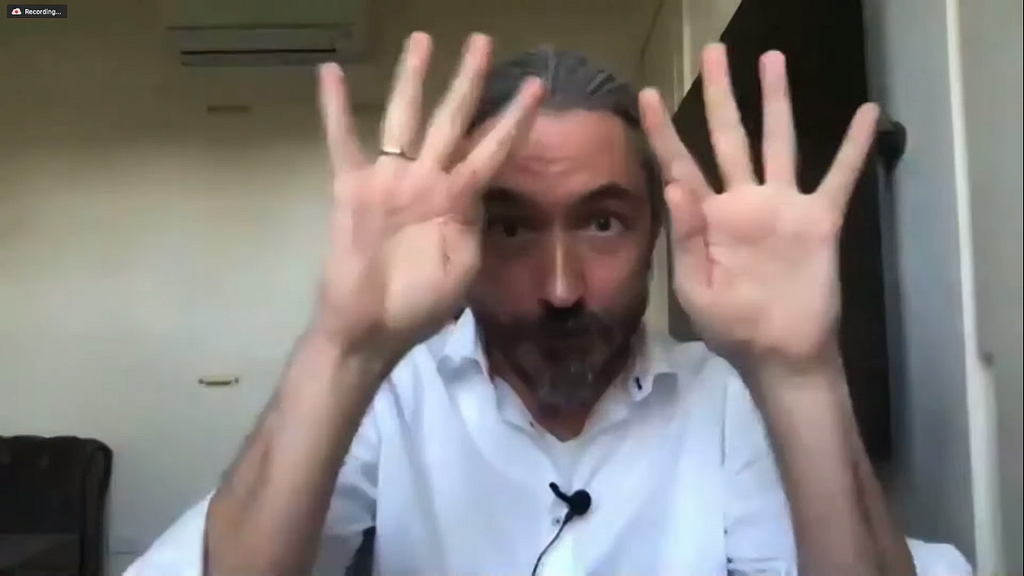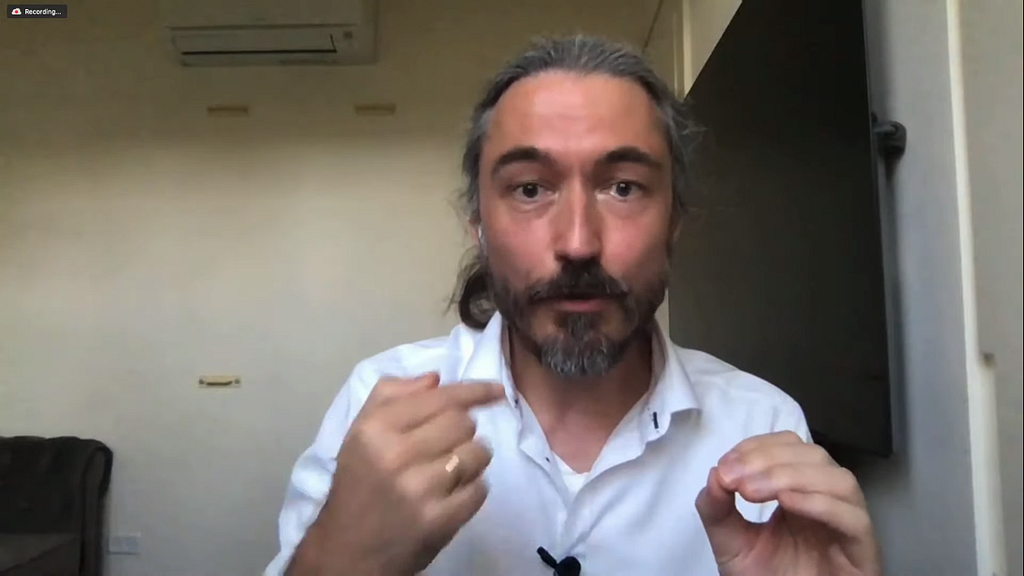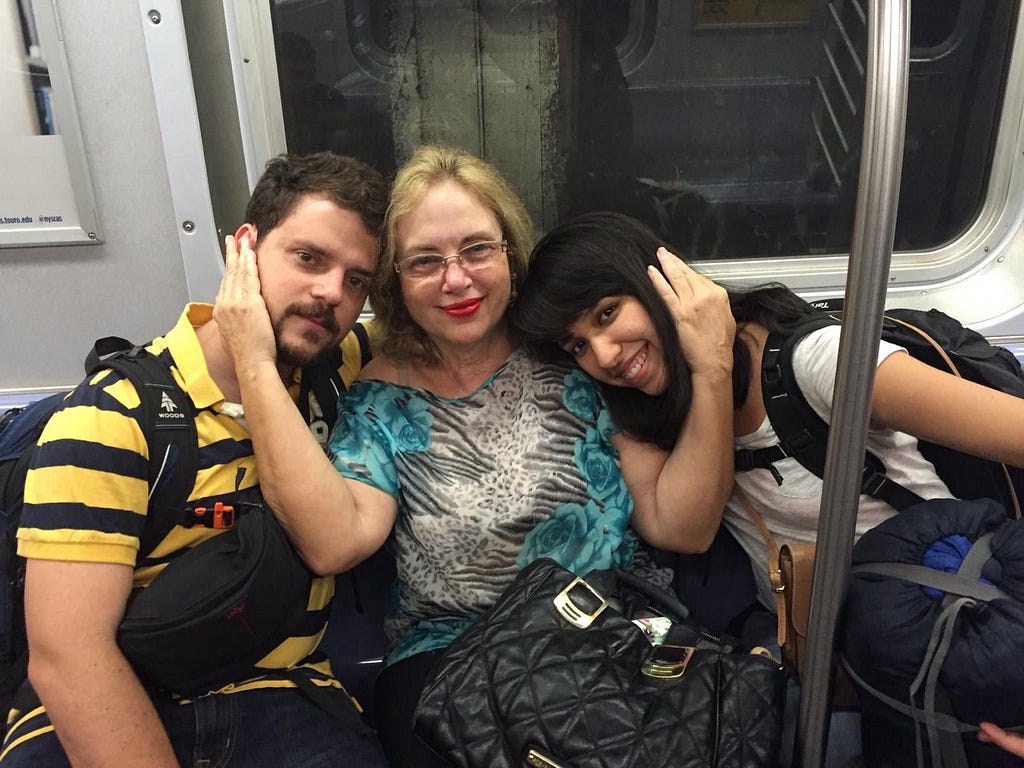This article was originally written by Helio Borges

“One of the greatest pandemic trauma symptoms in the world, besides numbness and hyperactivity, is the fragmentation of my mind, my emotions, and my body. The three elements are not communicating the same thing.” Thomas Huebl
In the 4th session of GAIA, Otto Scharmer welcomed Thomas Huebl. Thomas is the founder of the Academy of Inner Sciences, and of The Pocket Project. Otto began with this question: “What is it in your own life that made you work with collective trauma for so many years and hold large group gatherings around that subject?”
In response, Thomas shared: “You can’t change consciousness unless you make the system see and sense itself.”
https://medium.com/media/9793021669e53410aad4255950584210/href
He continued: “Eighteen years ago I facilitated workshops to a lot of groups around the world. Many of them were in Europe. Very soon I saw that collective eruptions in my groups began. There were collective eruptions of 50–60 people at the same time starting to cry because they had seen horrible images from WWII and the Holocaust. It happened it happened over and over. After some time I realized that I was learning something about it and I started to study it. I have gone deeper and deeper for the last eighteen years. We ran such groups many times around the world. There are a few things that I learned.”

A Pocket of the Past
Thomas continued to explain, “Trauma is a process where I experience something in my present being. It is so overwhelming that I can’t process it. I split off that part of myself with the tremendous overwhelm and I numb it. That part becomes the past. I often say that an integrated history is Present, and an unintegrated history is the Past. That pocket of the past creates a mirror in the future that is not the real future.
It is not the future that you create by going deep into the “U” and harvesting within the source, your future inspiration. No, it creates the future that is needs to integrate that past. A lot of our humanity’s past has been created with a lot of transgressions made while living with each other. A lot of pain has been inflicted, like when millions of people were put on concentration camps. That is a lot of pain, a lot of dissociation, a lot of atrocities. So, once that past has been created, it needs to integrate with its future mirror bubble, for healing, reintegration, and resurrection, in order to form a vertical alignment. That is why I love your work with Vertical Literacy.”

We Make Trauma Normal
Thomas further explained that vertical alignment can only be possible when life is restored. He described how there are absent parts of our social and individual life, parts that we do not see and feel, that need to be re-incorporate in order to sense and see in the present.

He shared an example, “for instance, this traumatic event is like a crazy thing that you watch on your TV, and then it gets so loud that you take the remote control and mute it. Immediately you take the TV set and throw it into the ocean. It slowly sinks into the ocean while still playing the movie. In our collective ocean, there are many of those TV sets that are still playing the scenes that have been muted back in time. I learned that not only was the individual trauma important, but it is super important to bring it into a much larger context. Trauma is not a stand-alone thing. When the traumas of the world appear on us, our perception is way smaller than the world we live in, and we create many more side effects by not sensing and not being.”

Closing the Organ of Perception
Otto responded with two points. The first point was resonating with the example that Thomas provided about the 50–60 person workshops. He shared, “we breathe collectively like we do here in GAIA or any kind of group, and what happens when manifesting your own experience is that it’s not just your own experiences of the past, but that your own experiences are microcosmos of the collective. There is an individual and a collective dimension of it.”

The second point that Otto shared was that trauma is really a survival reaction. It is a built-in intelligence that has to do with this letting off and disintegration, which really is when it shows up on my experience, is not seeing, used this gesture, and the not feeling, not sensing, the numbing thing.
Otto: “Which is precisely the opposite of what Goethe is talking about, right? “Every object well contemplated opens up a new organ of perception.” Every trauma that is moving into the not seeing and not sensing is not opening the organ of perception, but it is closing it.”
Three Aspects of Trauma
Thomas described these aspects. First, we are all shareholders of this collectively traumatized field. It lives in us. One of the main fundamental symptoms of trauma is isolation and separation. There is numbness, hyper-reactivity, and all the scalations that come from it. But deep down, induced, because we have been born into it, is the feeling that we are separate. In an interconnected whole, everyone lives in everyone, already.

The second aspect that Thomas shared is that the world that we are born in is fragmented. We are used to broken glass. We photoshop the incongruencies of the fragmentation trying to erase the parts that we see. But the parts that we don’t see, we don’t ask about, because they don’t arise in us. He further explained “I try to integrate what I see or that disturbs me. When someone talks to me and I get very angry, I see a symptom. There is fragmentation that became social agreements and many social structures. Social absence is the process behind the trauma fragmentation, the symptom of it. The trauma fragmentation is intelligent because it keeps us surviving.”
Thomas: “The one way to realign the intelligence of the process of splitting is to be willing to feel uncomfortable. We have to be willing to feel the discomfort of that which we excluded in the past.”

Third, Thomas shared about the process of integration:
“We are the bricks in the house of humanity. We are not outside of the house of humanity. That is where the paradigm of science comes into place, because one of the most pandemic trauma symptoms in the world, besides de numbness and hyperactivity, is the fragmentation of my mind, my emotions, and my body. The three elements are not communicating the same thing.
Integrating is not about arriving, it is about making the next step with high competence. The world is changing and then I will make the next step, and again, and again. Like the beautiful sentence of Lao-Tzu, “ A journey of a thousand miles starts from beneath my feet.” The next step is very important because I don´t see the invisible canyon that I have to go through, but it seems to me that I can get to the other side easily. So Presence is the most fundamental capacity for the journey.”

Attuning Collective Coherence
Thomas shared that humans are often overwhelmed without fully noticing the design, for example,“let’s say a sniper enters a school. It is a very traumatizing experience. Ten minutes later, I get a CNN newsfeed on my phone. Now, being a contemporary witness means that I will read it in between my work tasks. I read the information but not the information within the information.
The collective event is never separated from the inability to perceive it. It is very powerful because it means that the event “shooting in the school” is entirely connected to everybody who cannot feel it. They are interdependent. The reason I am saying this is that I am going to lead you into a practice where we can see whether my mind, my emotions, my body, my awareness, tune-up. Because it is kind of an instrument that I tune to building coherence. Then we will look at two or three aspects of the collective culture that are symptoms of collective trauma.”
Thomas: “There is an aspect in collective trauma that I want to relate to a powerful saying on the Bible when the Jewish people were meeting on mount Sinai and God spoke to all of them, and everyone said: “God spoke to me personally”. When you did the sculptures, every individual held a piece of the information code for the whole. Once they become attuned, that is when Presence really happens. The collective presence is a strong resource, so, we are going to attune the collective coherence.”

Social Resonance
Otto then invited Olaf Baldini to share his scribing of the session and to comment on it. Olaf did not articulate a word about it, he just signaled his artwork. It shows darkness, sadness, pain, a fragmented being, collective trauma, on the right-hand side. However, it also shows a way out of all that suffering that conducts to what seems to be a sea of light. Otto invited us to let the image sink in with our attention in our minds and hearts, to notice what we see, sense, and feel when we see the image.

Antoinette, another moderator, read some of the sentences shared on the chat. I see the gap. I see the illumination. I feel hope. I see a blank page on the other side of the trauma. I felt trapped. I see the light rising through the window. I see a deep sadness that connects us all. I sense an opening. I feel shivers of truth. I see a whole new perception. I see amazing revelations in our collective process. I see a fragile opening.
To Change the World, We Need to be Changed Too
Thomas closed the session by saying: “This is exactly the kind of learning that you need, offering all the kind of learnings that you display here because it is holistic learning. The information that forms life needs the whole being in us, all of our capacities, and I think that you have beautiful elements that are speaking to the whole being of the human being, thank you for that.”

Thomas: “Like a soccer player, you train capacities to be part of the team. It has the power of dedication and awareness and real participation. That is the way that you can change the world, but we need to be changed too in order to be informed by life.”
Collective Trauma is Personal
I (Helio) did not consider myself a victim of trauma because I am an optimist person by nature and by formation. My work is to be a catalyzer for change in individual people and organizations, which is a very rewarding job from a life purpose standpoint. Additionally, I have a happy marriage of 36 years with my beautiful wife Ileana, and I have three wonderful sons. This GAIA session was especially relevant for me because I had not noticed that I had been carrying with me that pocket of the past that Thomas spoke about.
My Pocket

I became aware of the fact that my family and I have both, societal trauma and the trauma of separation. All my brothers but Andrés live abroad, Nelson in Houston, Alberto in Belgium, Alvaro in Spain, and my little sister Chiqui in Ecuador. So what? Everyone has siblings living abroad. Nevertheless, when your 90 years old mother has to migrate with her little sister to an alien country because she is not safe in her own, that is wide-open trauma. *That knife-like trauma cuts through her heart and the heart of her children. Every time that I speak with her on a video call, something inside me tells me that it might have been the last time. That trauma increases when her only caretaker, my sister, is a physician working on the COVID-19 ICU in a hospital in that country.
My eldest son, Helio Daniel, is a resident of Montreal, Canada. When we applied for a tourist visa to Canada three years ago, the Canadian government refused it. We had to meet in Cancun, and a year later in New York. Tears come to our eyes every time that we remember our farewell dinner and our last subway ride to the Port Authority Bus Terminal.

Last Sunday, mother’s day, was one of those times when the separation was more present than ever.
I live in Caracas, Venezuela, with my other two sons, Miguel and Ignacio. My second son, Miguel, is an engineer who works for Medecins Sans Frontiers refurbishing and building field hospitals in the Venezuelan COVID-19 task force. Every time that he is on the field, which is all the time, my wife can’t sleep. Furthermore, from a societal standpoint, Venezuela is one of the hottest spots on the planet because of the extreme polarizing issues affecting us. More than 20 years of continuous political confrontation have brought about the destruction of the economy, the disintegration of the society, a totalitarian regime, thousands of deaths, millions of emigrants, and widespread suffering. On top of that, Covid-19.
Integrating my Fragmentation
I had been carrying that weight in my pocket of the past without even realizing it. But, while I was listening to Thomas, I felt a cascade of repressed emotions running free, and as I am writing this article, I feel the same. Now I know that reintegrating trauma is not a matter of switching it ON. It is a process of being PRESENT so I can face it with my heart wide open, feeling that oppressing sensation on my chest and doing nothing to repress the tears coming out of my eyes. Trauma is an experience that you most live because it lives in you, whether you know it or not. The more you live it, the more the pain is released, and eventually, it will go away. Eventually.
Being Present
I have been feeling like that since the GAIA Journey event last Friday. Today is Tuesday, and I feel fortunate about having had the opportunity to face my personal trauma. Somehow, now I feel different; I have a wider perspective of things. Nevertheless, with reintegration comes new responsibilities. Now I know that I need to hold the space to help the members of my family to cope with it, by listening to them. Now I know that when I face a person who has a different political point of view, I do not need to react because he or she might be suffering a trauma probably much worse than mine. Now I know that the coherence that I need to be PRESENT, comes from an integrated inner source, not a fragmented one. Now I know that every time that I am PRESENT, I am going to relive my personal-collective trauma. If that’s the way it should be, so be it. I am willing to feel the discomfort of what I have excluded in the past. I want to be a member of the team and I want to change the world, but as Thomas said, I need to change first.
Do You Have a Pocket of the Past?
If you feel that for whatever reason you might have one of those pockets of the past with you, I strongly recommend that you watch the recording of the GAIA Journey session featuring Thomas Huebl embedded above, at the beginning of the article. Additionally, you can access Thomas Huebl’s guided meditation in section 1:14:00 of that recording.
*Postscript
On June 11th at exactly 11.00am, I received a call from my brother Andres. The moment that I saw his name on the phone screen I sensed what he was calling about. He said to me that my mother had just passed away. I immediately called my sister and she said that she had died in peace. On a later call, she explained to us in detail that she had passed with a smile on her face, listening to La Traviata. Somehow, that news brought some peace not only to me but to all of my brothers living in different parts of the world. Thank you.
Originally published at https://medium.com on May 16, 2020.
Systems Sensing: Attending to Collective Trauma was originally published in Field of the Future Blog on Medium, where people are continuing the conversation by highlighting and responding to this story.
Tagged with :







